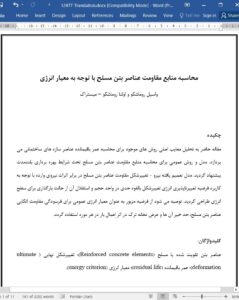Abstract
The article analyzes the main disadvantages of existing methods for calculating the residual life of building structure elements. A universal model and method for calculating the strength resource of reinforced concrete elements under conditions of long-term operation are proposed. The generalized deformation-force model of reinforced concrete elements resistance to force effects is developed up to the energy level due to the application of the hypothesis of invariability of the limiting potential deformation energy per unit volume and its independence from the loading mode. This hypothesis is recommended to be used as a universal energy criterion for the reinforced concrete elements bearing strength exhaustion, limiting their deflections and crack opening widths under the action of loads of any duration.
1. Introduction
Establishing the building elements and structures actual stress-strain state with the determination of their residual resource will always remain one of the priority tasks that have to be solved during the reconstruction and modernization of building objects. This task is especially difficult for reinforced concrete elements, since it requires modeling their real stiffness characteristics during long-term operation. The overwhelming majority of the existing methods, the actual technical condition of the exploited reinforced concrete elements and structures is assessed according to the materials corresponding strength characteristics and the identified defects and damages totality. Under such circumstances, the reinforced concrete elements stiffness during their operation can be modeled only using the geometric parameters of their section. At the same time, it is known that a change in stiffness due to deformation parameters, in particular a decrease in the modulus of concrete deformations due to its creep, is more significant, since it can occur even without changing the geometric characteristics of the compressed cross-section of elements or structures. And in bending elements, it is the change in the mentioned deformation parameter that is also accompanied by a change in the geometric characteristics of the reinforced concrete elements section due to the deflections development and crack opening under conditions of long-term operation.
5. Conclusion
Thus, based on the research results, the following conclusions can be drawn: the application of the energy criterion of the reinforced concrete elements and structures bearing strength exhaustion allowed to develop a generalized deformation-force model of their resistance to force to the energy level; the hypothesis of invariance in unit of volume and independence from a loading mode of potential energy of a reinforced concrete element deformation allows to carry out calculation of its total and residual resources from uniform methodological positions; the use of the energy criterion of the reinforced concrete elements and structures bearing strength exhaustion allows to calculate their total and residual resources directly from the measured deformation parameters of field studies (deflections, pitch and normal cracks width); forecasting the reinforced concrete elements and structures residual life requires detailed studies of the concrete creep parameters.











